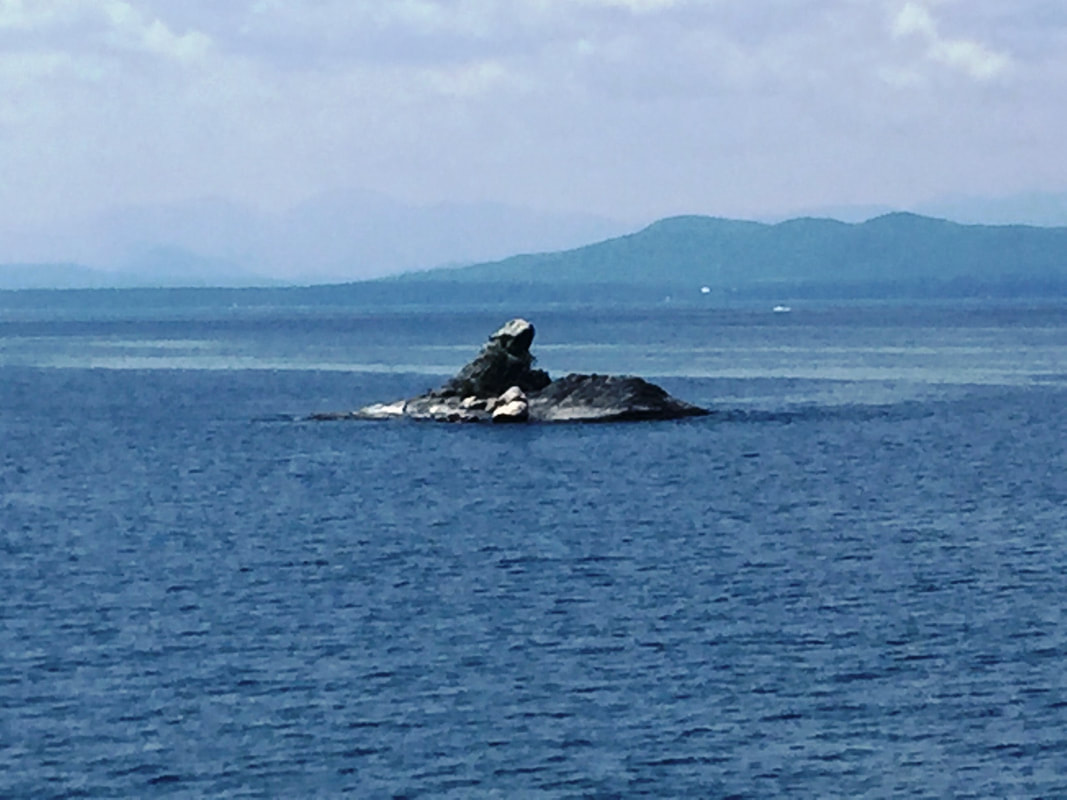In Lake Champlain, not far off the shore from Burlington, VT is a rock that stand out of the water which is not an island. On the cruise ship, “Ethan Allen” the narrator pointed out the rock as we passed, and shared a couple stories about it.
To the Abenaki, Native Americans of the area, the rock is Oodzee-hoza, the name of an ancient being who lived in the area. He was said to have no legs or short legs, but very long arms to drag himself around the earth. He used those arms and his hands to create the hills, the valleys and the path of the rivers. The last thing he made was the lake, his masterpiece. He then transformed himself into the rock standing out of the water so that he might admire his creation in all its entirety. For hundreds of years the Abenaki would go out on the lake and offer pipes and tobacco to Oodzee-hozo, thinking if you allowed him to smoke, he would calm the winds to allow safe voyages across the lake
The rock has another name: Rock Dunder, less romantic. This name supposedly comes from an incident during the Battle of Valcour, part of the Revolutionary War, which took place on the lake. Nightfall found the American vessels blockaded, but they managed to slip out and flee south. In the morning, the British realized the Americans had gotten past, and so turned and fired after them. “In the morning fog, they fired on Rock Dunder, believing it to be a vessel. Only later, when the fog cleared did they realize their mistake. According to legend, the officer in charge cried out, “It’s a rock, by Dunder!” earning the place its name.
In more recent times, two versions of the story met up, in a sense, when a group of boaters thought it would be a good idea to blow up the rock with dynamite, to clear the channel for ships and boats coming into port. Only the Abenaki asked them not to, and explained why. And so the rock remains, without a light, without trees, without visitors except those who may be paying a call to a being who they believe continues to enjoy and to share his most beautiful creation.
It’s an interesting history for a rocky outcropping in the middle of the lake. But the message may be about the stories we hear as we grow up in this world, and the stories we tell to others and our children. What do the stories reveal, and what importance do they signify? And, what stories do we choose to take in and to live by?
To the Abenaki, Native Americans of the area, the rock is Oodzee-hoza, the name of an ancient being who lived in the area. He was said to have no legs or short legs, but very long arms to drag himself around the earth. He used those arms and his hands to create the hills, the valleys and the path of the rivers. The last thing he made was the lake, his masterpiece. He then transformed himself into the rock standing out of the water so that he might admire his creation in all its entirety. For hundreds of years the Abenaki would go out on the lake and offer pipes and tobacco to Oodzee-hozo, thinking if you allowed him to smoke, he would calm the winds to allow safe voyages across the lake
The rock has another name: Rock Dunder, less romantic. This name supposedly comes from an incident during the Battle of Valcour, part of the Revolutionary War, which took place on the lake. Nightfall found the American vessels blockaded, but they managed to slip out and flee south. In the morning, the British realized the Americans had gotten past, and so turned and fired after them. “In the morning fog, they fired on Rock Dunder, believing it to be a vessel. Only later, when the fog cleared did they realize their mistake. According to legend, the officer in charge cried out, “It’s a rock, by Dunder!” earning the place its name.
In more recent times, two versions of the story met up, in a sense, when a group of boaters thought it would be a good idea to blow up the rock with dynamite, to clear the channel for ships and boats coming into port. Only the Abenaki asked them not to, and explained why. And so the rock remains, without a light, without trees, without visitors except those who may be paying a call to a being who they believe continues to enjoy and to share his most beautiful creation.
It’s an interesting history for a rocky outcropping in the middle of the lake. But the message may be about the stories we hear as we grow up in this world, and the stories we tell to others and our children. What do the stories reveal, and what importance do they signify? And, what stories do we choose to take in and to live by?

 RSS Feed
RSS Feed
